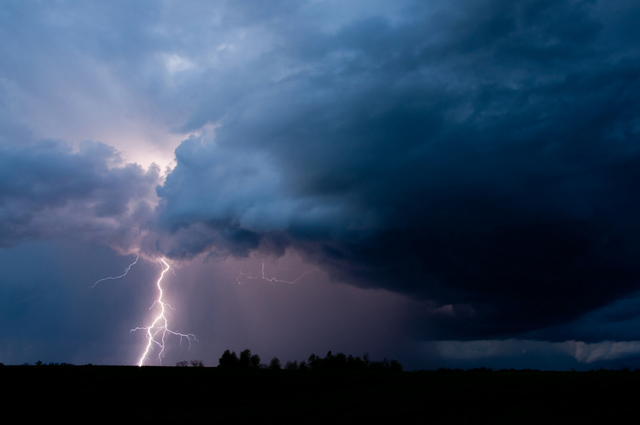Don’t wait in seeking shelter from the storm
The 16-year-old girl was sitting at the school’s picnic table, watching the storm, when a friend yelled out and advised her to come inside. She replied, “I love storms.” The friend then heard a “bang” and witnessed the girl being directly struck and thrown to the ground.
According to EMS, she was unconscious and without a pulse when they arrived. Upon arrival to our Emergency Department, she was already intubated and had ROSC after several rounds of CPR pre-arrival. Contrary to what many believe, most lightning victims die due to cardiopulmonary arrest and not secondary to “burns.”
Unlike electrical burns where there is concern for deep tissue necrosis, entry and exit wounds and rhabdomyolysis; lightning tends to spread over the body and into the orifices causing tympanic membrane rupture, cardiac arrhythmias, respiratory center paralysis, pathognomonic skin markings and blunt trauma from being thrown. However, lightning strikes are primarily a neurological problem having lasting effects on the CNS, as well as autonomic and peripheral nervous systems.
Keraunoparalysis which is an ANS-mediated vasospasm may also present with pallor, pulselessness and paralysis of the lower limbs which normally resolves on its own but can mimic spinal cord injury.
Luckily, our patient did well after her cardiopulmonary arrest. She was admitted, monitored and hydrated. Although she ruptured both of her tympanic membranes, she was extubated within 24 hours and continues to do well despite some mild neuropsychological deficits, mainly affecting her memory.
It seems most everyone enjoys an early spring or summer storm, and our fascination with the electrical display of a “good” storm may only be comparable to the mesmerizing effects of staring into a roaring campfire. However, there is a lot of confusion surrounding the prevention, risks and treatment of lightning injuries. It always puzzles me when I see hikers carrying bear bags, guns, bear spray, bells and other tools to protect themselves, and then I see those same hikers crossing over a ridge in an afternoon thunderstorm without a care in the world.
While bears do sometimes attack (and I’m not proposing you ignore bear safety), lightning strikes injure or kill many more people on an annual basis. Lightning is the third leading environmental cause of death in the U.S. and has been responsible for about 50 people killed annually over the past 40 years. Another three to five times more people are struck and are not killed. In the U.S., over 90% of these strikes occur between May and September with the majority occurring between noon and 6 p.m.
Other potential injuries
The most common type of strike is from a side splash where the lightning literally “bounces” off an object and strikes the individual. When sustaining a direct strike, patients are more likely to have poor outcomes that result in death, but luckily only about 3-5% of strikes are direct.
Other types of injuries can be found from contacting an object that is struck or from the electricity traveling as ground current. Although there are many “rules” about predicting how far away a storm is and whether it is safe to be outside, just remember, if you hear thunder or see lightning you are at risk of being struck. Obey the saying, “When Thunder Roars, Go Indoors.”
Every year a number of outdoor enthusiasts are injured while being stuck in a storm, but often these injuries occur right on our back doorstep, at the local school baseball or soccer field. In fact, outdoor sports have the highest rising lightning casualty rate. I find it extremely important as emergency physicians to not only treat the patients in our department but to also help educate and prevent injuries in our communities.
It is therefore our duty to make sure players, coaches, parents and spectators take cover in an enclosed building or car (with the windows rolled up) until the storm has completely passed, not merely go to the sidelines or dugout to “wait it out.” Any structure that is open on any side increases the risk of being struck by a side-splash. If caught in an open field or a golf course, it is best to spread your party out, crouch down and minimize contact with the ground while covering your ears. Do not sit under a tall tree or object to protect yourself from getting wet. Being close to something tall only increases the risk of being hit by a side splash or via contact with the object.
There have also been several lightning multi-casualty case reports. One such incident occurred in Kings Canyon when five adults and seven teen Boy Scouts were caught in a storm 53 miles from the trailhead. Two were in cardiopulmonary arrest, six were knocked unconscious and four were unharmed (1).
If you find yourself in a similar situation, remember “Reverse Triage.” With lightning injuries, you should actually go to the sickest and/or unresponsive “dead” patients first, as often times their temporary arrest will recover with good bystander CPR. Be sure to continue respiratory support if needed as often the cardiac arrest is shorter than the respiratory paralysis and if not addressed can lead to a secondary arrest. In addition, lightning strikes often cause fixed and dilated pupils and should not change your decision to pursue CPR. Whereas in most multi-casualty events, the dead are ignored and you focus on those you may be able to prevent from dying.
Conclusion
As we enter the midst of the summer sports season, the next time you are outside and caught in a major storm, please strongly encourage everyone to take cover in an enclosed structure, even if you embarrass your poor child. You just may save a life.
References:
(1) Spano SJ, Campagne D, Stroh G, and Shalit M. A lightning multiple casualty incident in Sequoia and Kings Canyon National Parks. Wilderness Environ Med. 2015 Mar; 26(1): 43-53.



